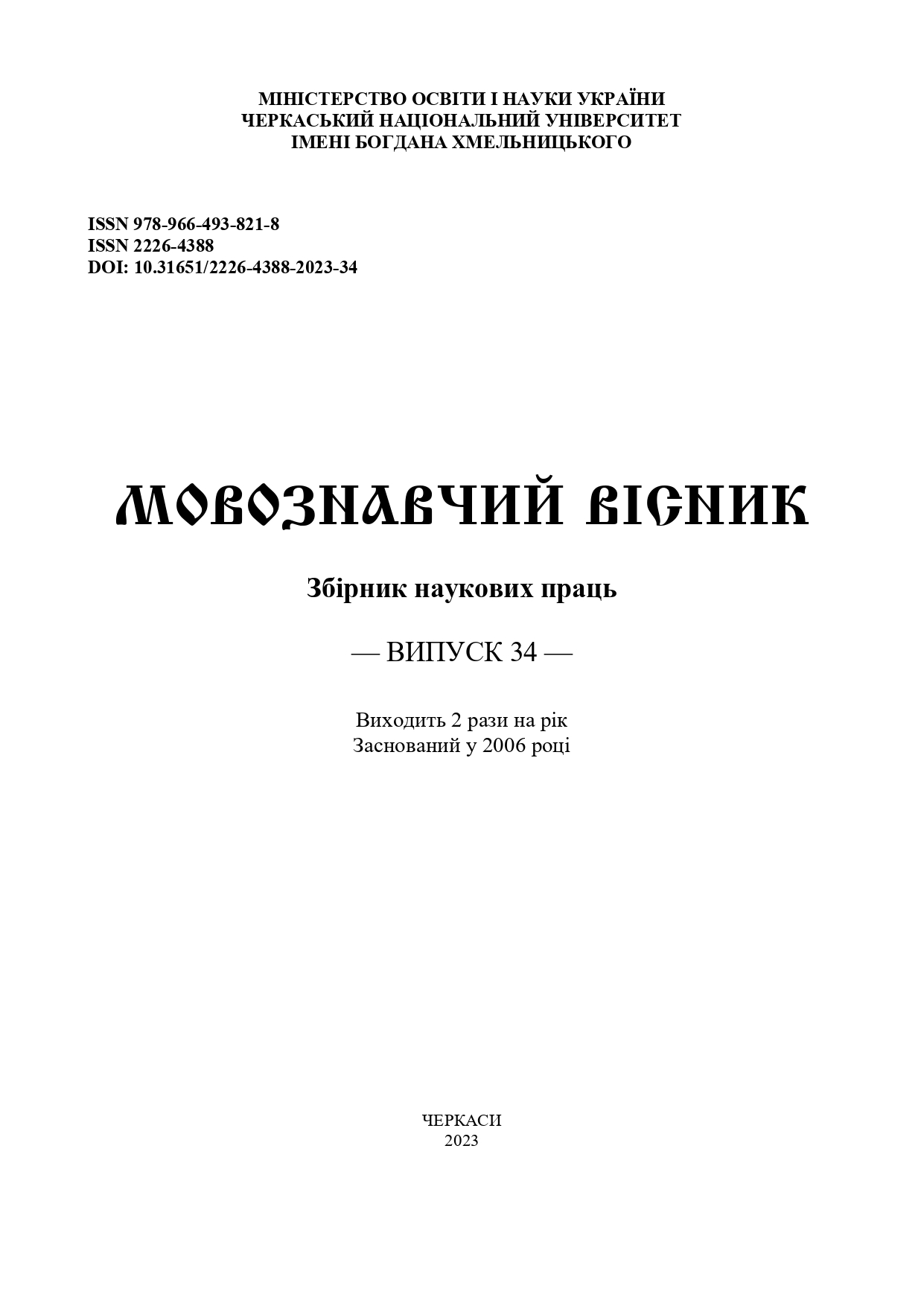UKRAINIAN PROVERBS AND ANTI-PROVERBS AS ELEMENTS OF MEMES
Main Article Content
Abstract
Introduction. This article is devoted to a relatively new phenomenon in the media space –the Internet meme, which is a unit of information that spreads from one native speaker to another, like a virus. The topicality of the research is determined by the increased interest in the function of the Ukrainian language on the Internet, new strategic possibilities of communication in the modern polydiscursive world.
Owing to new ways of communication, various linguistic units arise, knowing them means the possibility to
fully communicate with other network users both on the Internet and outside of it.
The purpose. The purpose of the article is to analyze the peculiarities of the interaction between the verbal text and the visual component in Internet memes built on the basis of Ukrainian proverbs and antiproverbs.
The methods include random sampling technique and discourse analysis.
Main results of the study. The article examines Ukrainian proverbs as elements of Internet memes, analyzes the tactics of interaction between verbal text and images. Based on the use of popular Internet memes, we established patterns of their development and distribution, as well as factors affecting their success and popularity. Proverbs as components of memes reflect their inherent specific humor and nonconformity. They often have a negative and provocative tone, which makes them easier to remember.
Originality. The study shows that a large number of proverbs can be found in internet memes.
Proverbs perform several important functions, acting as a means to initiate a humorous effect, establish a dialogue with the reader, convey subtext or establish an intellectual game. The study demonstrates that
proverbs are related to the cognitive domain, as they form a cognitive field that includes different speakers.
In summary, proverbs play an important role in Internet memes, which is justified by the high frequency and
variety of representation in Internet memes.
Conclusions and specific suggestions of the author. The conclusion is made about the nature of the Internet meme, which is based on a precedent phenomenon, and the functions that the Internet meme performs. As Internet memes themselves lack any deep meaning, they fulfill their major purpose by referring a linguistic personality to the relevant information accessible to a certain reference group. The more important the information is, the more likely the meme is to become truly popular.
Article Details
References
Assman, A. (2012). Prostory spohadu. Formy transformatsii kulturnoi pamiati [Spaces of memory. Forms
of cultural memory transformation]. Kyiv: Nika-Tsentr, 440 (in Ukr.).
Buryak, V. D. (1994). Ukrainskyi humor ta satyra yak psykholohichno-khudozhnia dominanta obraznoi
svidomosti (na materiali usnoi ta pysemnoi slovesnosti ХІV–ХVІІІ st.) [Ukrainian humor and satire as a psychological
and artistic dominant of figurative consciousness (on the material of oral and written literature of the 14th–18th
centuries)]. In : Satyra i humor v ukrainskii literaturnii tradytsii [Satire and humor in the Ukrainian literary tradition].
Chernivtsi: ChDU, 4–7 (in Ukr.).
Zabotnova, M. V. (2021). Internet-memy yak zasib realizatsii stratehichnoi komunikatsii [Internet memes
as a means of implementing strategic communication]. In: Filolohichni studii [Philological studies], 17, 30–38 (in Ukr.).
Barthes, R. (1961). The photographic message. In : Communications, 1, 127–138 (in Еng.).
Barthes, R. (1964). Elements de semiologie. In : Communications, 4, 91–135 (in Еng.).
Barthes, R. (1991). The fashion system. Berkeley: Univ. of California Press, 352 (in Еng.).
Dancygier, B. & Vandelanotte, L. (2017). Internet memes as multimodal constructions. In : Cognitive
Linguistics, 28 (3), 565–598 (in Еng.).
Dawkins, R. (1976). The selfish gene. New York: Oxford University Press, 386 (in Еng.).
Giesea, J. (2015). It’s Time To Embrace Memetic Warfare. In : Defence Strategic Communications. The
official journal of the NATO Strategic Communications Centre of Excellence, 1, 1, 67–75 (in Еng.).
Hrisztova-Gotthardt, H., Varga, M., Litovkina, A. & Vargha, K. (2020). The Visual Representations of a
Biblical Proverb and Its Modifications in the Internet Space. In : European Journal of Humour Research, 8 (2), 87–112
(in Еng.).
Knobel, M. & Lankshear, C. (2007). Online memes, affinities, and cultural production. In : A New
Literacies Sampler. New York: Peter Lang, 199–229 (in Еng.).
Kozioł-Chrzanowska, E. (2017). Well-known Polish proverbs in Internet memes. In : Proverbium, 34, 179–
(in Еng.).
McGraw, A. P. & Warren, C. (2010). Benign violations: Making immoral behavior funny. In :
Psychological Science, 21, 1141–1149 (in Еng.).
Mieder, W. (1989). American proverbs: A study of texts and contexts. Bern; New York: Peter Lang, 396
(in Еng.).
Mieder, W. (1993). Proverbs are never out of season: Popular wisdom in the Modern Age. New York &
Oxford: Oxford University Press, 284 (in Еng.).
Milner, R. (2016). The World Made Meme: Public Conversations and Participatory Media. Cambridge:
MIT Press, MA, 264 (in Еng.).
Piekot, T. (2012). Pictorial representation of idioms in Internet humour. In : Estonia and Poland creativity
and tradition in cultural communication. Tartu: ELM Scholarly Press, 1, 187–203 (in Еng.).
Rose, G. (2007). Visual Methodologies: An Introduction to the Interpretation of Visual Materials. London:
SAGE Publications, 240 (in Еng.).
Shifman, L. (2013). Memes in a Digital World: Reconciling with a Conceptual Troublemaker. In : Journal
of Computer-Mediated Communication, 18 (3), 362–377 (in Еng.).
Szpila, G. (2017). Polish Paremic Demotivators: Tradition in an Internet Genre. In : Journal of American
Folklore, 130, 305–334 (in Еng.).
Tenove, K. (2019). The Meme-Ification of Politics: Politicians and their «Lit» Memes. Available at :
https://theconversation.com/the-meme-ification-of-politics-politicians-and-their-lit-memes-110017 (in Еng.).
Terskikh, M. V. (2019). Verbal-Visual Means of Representing Gender Stereotypes in Modern Advertising.
In : Nauchnyi dialog, 11, 86–99 (in Еng.).

